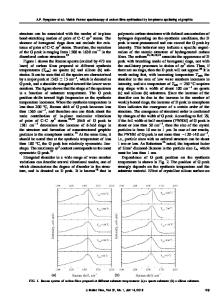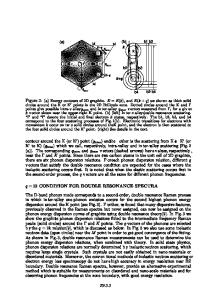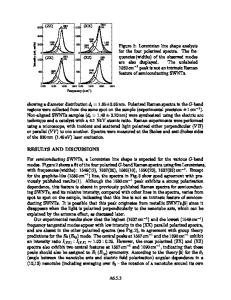Anisotropy in the Phonon Dispersion Relations of Graphite and Carbon Nanotubes Measured by Raman Spectroscopy
- PDF / 184,372 Bytes
- 6 Pages / 612 x 792 pts (letter) Page_size
- 94 Downloads / 347 Views
F8.10.1
Anisotropy in the Phonon Dispersion Relations of Graphite and Carbon Nanotubes Measured by Raman Spectroscopy Georgii G. Samsonidze,1 Riichiro Saito,4,5 Ado Jorio, 2,6 Antonio G. Souza Filho, 2,7 Alexander Grüneis,4 Marcos A. Pimenta,6 Gene Dresselhaus,3 and Mildred S. Dresselhaus1,2 Department of Electrical Engineering and Computer Science, 2Department of Physics, Francis Bitter Magnet Laboratory, Massachusetts Institute of Technology, Cambridge, MA 02139-4307, U.S.A. 4 Department of Electronic Engineering, University of Electro-Communications, and 5 CREST JST, Tokyo 182-8585, Japan 6 Departamento de Física, Universidade Federal de Minas Gerais, Belo Horizonte, MG 30123-970, Brazil 7 Departamento de Física, Universidade Federal do Ceará, Fortaleza, CE 60455-760, Brazil
1
3
ABSTRACT The possible semiconducting device use of single wall carbon nanotubes (SWNTs) requires a technique for the determination of the exact structure of the nanotubes assembled in the device configuration. Raman spectroscopy has been established as a precise and non-destructive tool for the characterization of graphitic nanostructures. Double resonance theory, which is used to explain the dispersive nature of the Raman bands, has attracted much attention for its potential use for the characterization of the electronic and phonon spectra of these nanostructures. Dispersive features in the Raman spectra of low dimensional graphitic materials, such as carbon nanotubes, can be used to measure directly the anisotropy, or the trigonal warping effect, in the phonon dispersion relations about the hexagonal corner of the Brillouin zone (BZ) of graphite. INTRODUCTION Single wall carbon nanotubes (SWNTs) have much promise for nanotechnology applications, being either metallic or semiconducting depending on their chiral symmetry. Raman spectroscopy has proven to be an effective characterization tool for SWNTs, as it is very sensitive to both electronic and phonon dispersion relations as well as to electron-photon and electron-phonon interactions in SWNTs [1]. Recent advances in the observation of Raman spectra from isolated SWNTs raises to a new level spectroscopic characterization of SWNTs and of the whole family of graphitic materials. Both electronic and phonon dispersion relations of graphitic materials show anisotropic behavior, which can be seen as distortions of equi-energy contours from a circular shape. Raman scattering on isolated SWNTs can be used to probe individual vibrational modes at the nanoscale level, and thus to measure the anisotropy in the phonon dispersion relations, due to quantum confinement in one-dimensional (1D) SWNTs. The phonon anisotropy is essential for material characterization, as it is responsible for many physical properties of carbon nanotubes, such as the trigonal warping effect [1]. Inelastic neutron scattering [2] and double resonance Raman spectroscopy [3] have been widely used to study the phonon dispersion relations of various graphitic materials. Phonon dispersion relations are commonly described by
Data Loading...











